Already in its 6th generation, the Galaxy Fold series has, without a doubt, fully matured. The latest addition to this line-up is the Samsung Galaxy Z Fold6.
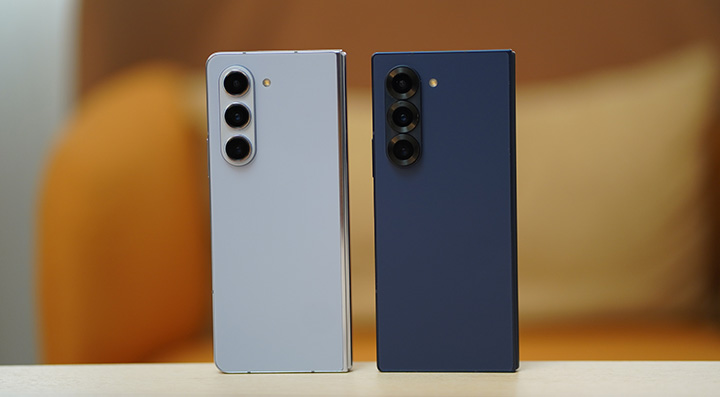
Compared to its predecessor, the Z Fold5, the Galaxy Z Fold6 got some minor external revisions that might not be that significant at first but is surely very much welcomed.
And just like how the S24 Ultra got took off from the S23 Ultra, we see the same approach with the how Samsung further refined the Galaxy Z Fold6.

In this review, we’ll identify how the new iteration is better and where the company is shifting its focus on their flagship series. Will the improvements be enough for Samsung to maintain its foothold in the foldable market?
Check out our review of the Samsung Galaxy Z Fold6 to find out more.
Table of Contents
From the exterior, there seems to be very little change between the Z Fold5 and the Z Fol6. The most subtle, yet obvious when held for the first time, is the more blocky or chunky body with sharper corners. Samsung also did the same with the Galaxy S24 Ultra and it was a change that we did not liked with that device.
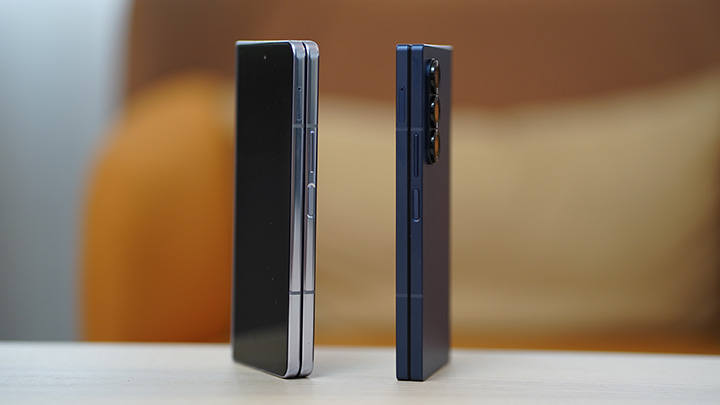
However, with the Galaxy Z Fold6, we find the blocky chassis a bit more comfortable to hold because it allows for a firmer grip. Besides, the Z Fold6 is much thinner now at 5.6mm (vs. 6.1 mm on the Z Fold5) and lighter as well (239 grams vs. 253 grams).

It’s not the thinnest nor lightest among foldables, but at this point, who’s even counting anyway? You still need the device to be strong and durable, capable of withstanding accidental drops, twists and even bending inside your back pocket.
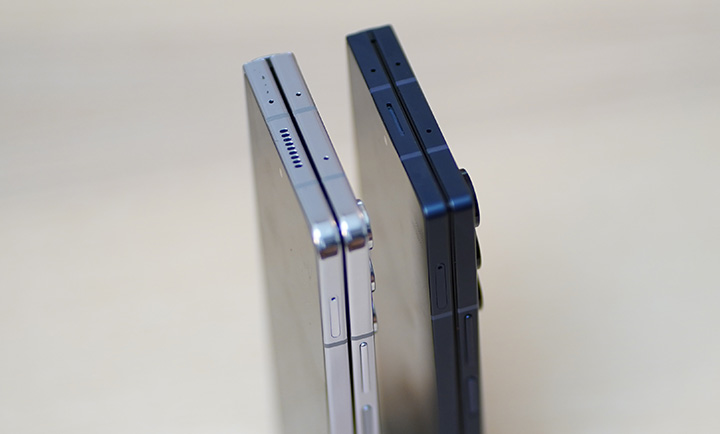
We also liked the matte finish of the metal frame (Armor Aluminum) which goes all the way to the hinge. We also love the Navy blue color of our review unit.

Speaking of the FlexHinge, it has been further improved so that it can complete close all the way flat, compared to the slightly angular fold of the Z Fold5. This, along with the redesign of the stereo speakers, allowed the Z Fold6 to have a dust-resistance rating of 4 from nil with the previous generation.

What’s a bit bothersome would be that protruding triple-camera system at the back.
The back panel has soft matte or powder finish which is actually made of Corning Gorilla Glass Victus 2, the same glass material used in the front cover display.

When unfolded, you will clearly see all the ports and buttons that line the entire sides of the device.
On the right side, we have the volume rocker and the power button that doubles as a fingerprint scanner while the SIM card slot is found on the left.
Up top, we have 3 microphones and one of the stereo speakers. At the bottom, we have the primary microphone, the primary speaker and the USB Type-C port.
The device is IP48 Rated which means it has minimal resistance to dust (1mm) but covered for water-resistance of up to 1.5 meters in under 30 minutes.
The cover display of the Z Fold6 is actually slightly bigger because Samsung adjusted the width and height of the device — it’s now a bit shorter but slightly wider. This did not really significantly affected the sizes of the cover and main displays (7.8-inch and 6.3-inch).

The main screen has 7.6-inch Dynamic AMOLED 2X display with QXGA+ resolution (2160 x 1856 pixels). It has a protective film that covers the display to provide some level of resistance from scratches but not from drops or bumps. due to the thin, soft layer of film (and we experienced this first hand).

The cover display has 6.3-inch Dynamic AMOLED 2X with a 2,376 x 968 pixels. This one is protected by Gorilla Glass Victus 2 so you don’t have to be extra worried with accidental drops scratches and dings. Of course, for added protection, you can slap a cover case so the device is more protected around the edges and corners of the glass display but it also adds a millimeter or two of thickness.
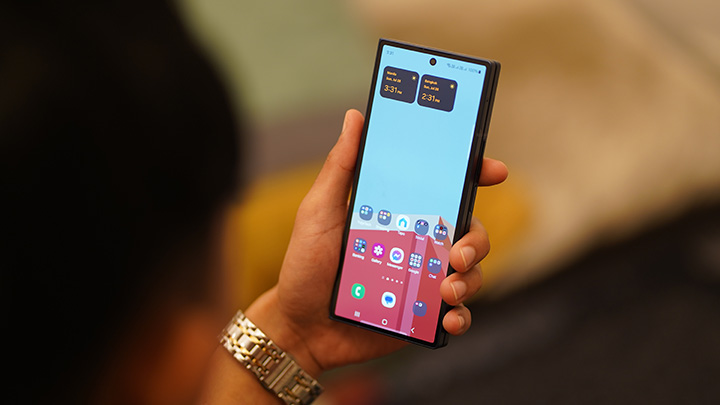
The Fold6 has two speakers — one at the top and another one at the bottom. They’re pretty clear and crisp, more than loud enough for the casual movie streaming, music playback or gaming. There’s no noticeable bass to speak of but, considering hoe thin the chassis is, we’re impressed with the over-all quality of the sound produced by the speakers.

As usual, the fingerprint scanner is embedded within the power button which I find a bit cumber some, especially if we’re all used to the under-display sensor. It’s fast and accurate although I often missed that spot when scanning my thumb so it takes longer to unlock than usual. In which case, I find the Face Unlock a much better option.
The Z Fold6 comes with a total of 5 cameras — 3 in the rear, one front-facing in the cover display and another one inside the unfolded display.

The rear camera are basically the same triple shooter as that of the Z Fold5 — a 50MP main with AF and OIS, a 12MP ultrawide and a 10MP telephoto with 3x zoom. This is almost identical tot he triple camera system of the Galaxy S24 Plus (they’re even tied in DxOMark rankings at 45th).

In general, the photos are great — accurate detail, good exposure and dynamic range, same vibrant colors that we’ve gotten used to with flagship Samsung cameras. Low-light and night shots are also very clean with a balance between shutter speed and ISO (usually 800-1600) to minimize noise.
The ultrawide camera also takes good photos but doesn’t have the same detail as the main camera and has lower exposure. The telephoto camera can zoom up to 3x but details are not as accurate as the main camera either.
For videos, the Z Fold6 can shoot up to 8k at 30fps or 4k @60fps with video stabilization. Clips are clean and crisp in daylight shots but noise is already noticeable when recording at night.
The Galaxy Z Fold6 comes with OneUI 6.1.1 based on Android 14. This is a slightly updated version from the one that came with the Galaxy S24 Ultra with Galaxy AI (version 6.1).

Nevertheless, this is the same clean and familiar interface that we’ve gotten used to with OneUI but with customizations to improve usability for foldable displays such as continuity between the cover display and the main display (though not the other way around).

Aside from the native Samsung apps (Galaxy Shop, SmartThings, Health, Wearable, Wallet, Find, Smart Switch), there’s not much 3rd-party apps pre-installed.
Most of the improvements that came with this update has to do with the Galaxy AI features that came with the Z Fold6 and Z Flip6. There’s a complete section for it inside the Settings, under Galaxy AI tab.
We have not really frequently used all of the built-in AI tools except for the Photo assist. While we think the rest of the AI tools are great, the frequency in which we think we’d used them does not offer that much value in the long run.
An additional 315MB is installed for the English language pack if you want to activate the Interpreter feature (great if you travel abroad a lot like me).
Also worth to note that the Z Fold6 also supports the S-Pen stylus (sold separately and attaches firmly at the back of the Z Fold6 case) so you can make sketches and drawings with the native Notes app and scribble on the any window screen.
Powering the Galaxy Z Fold6 is the latest chipset from Qualcomm — the Snapdragon 8 Gen 3 for Galaxy with Adreno 750 GPU. This is composed of a single high-performance Qualcomm Cortex-X4 processor running at 3.4GHz, a triple-core Cortex-A720 @ 3.15GHz, another dual-core Cortex-A720 @ 2.96GHz and a dual-core Cortex-A520 @ 2.26GHz.
Our review unit comes with 12GB of fast LPDDR5X RAM and 512GB of fast UFS 4.0 internal storage.

Take note that this variant of the Snapdragon 8 Gen 3 for Galaxy chipset has a higher clock speed for the Cortex-X4 processor at 3.4GHz compared to other variants (3.3GHz).

Check out the full suite of benchmarks we tested the device with:
Antutu Benchmark v10: 1,657,648
Antutu Storage:
Read: 4,183MB/s
Write: 2,714MB/s
Random: 950MB/s and 960MB/s (R&W)
PCMark Work 3.0 Performance: 18,511
Geekbench 6.3 CPU: 2,149 (Single core), 6,367 (Multi core)
Geekbench 6.3 GPU: 12,542 (OpenCL), 13,732 (Vulkan)

While the Z Fold6 is a very capable and powerful smartphone, we’re still a bit cautious when playing games especially with the main foldable display. We’re not worried with the cover display which is protected by Gorilla Glass Victus 2 but the half-screen isn’t too comfortable playing games.
Nevertheless, the Z Fold6 is, without a doubt, is powerful device that can handle anything we throw at it — be it for heavy gaming or handling multi-tasking apps.
Just like the Galaxy Z Fold4 and Z Fold5, the Galaxy Z Fold6 continued to use the same 4,400mAh battery. Given the thinner profile, we understand why they weren’t able to increase the battery capacity.

Where Samsung focused on is optimizing the system to draw less power and relying on the lower TDP of the new Snapdragon 8 Gen 3 chipset. The results is actually surprisingly good and showed significant improvements based on our own tests.
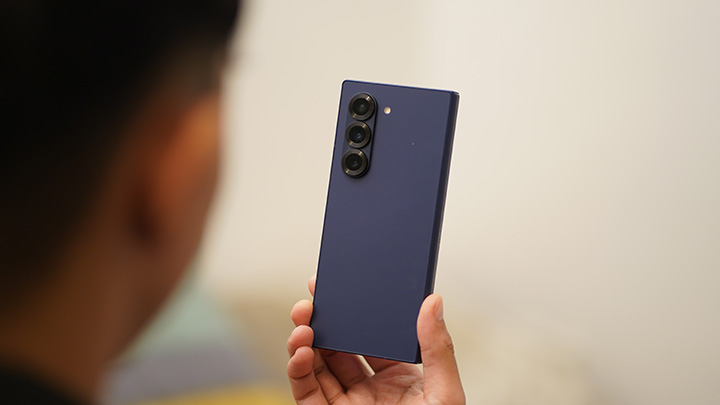
In our proprietary video loop test, the device lasted 39 hours and 46 minutes when folded and 30 hours and 55 minutes when unfolded. This is with playing a full HD movie at 50% brightness, zero volume and in airplane mode. These are better scores even when compared to the Galaxy S24 Ultra (28 hours and 5 minutes) under the same test.

In our gaming test, we played a few rounds of Mobile Legends while connected on WiFi, at 50% brightness and 50% volume. The Galaxy Z Fold6 lasted 7 hours and 13 minutes when folded and 6 hours and 20 minutes when unfolded. These are average results but still good enough in our opinion.
Lastly, using PCMark Work 3.0 Battery test, the Galaxy Z Fold6 score 15 hours and 36 minutes when folded and 10 hours and 36 minutes when unfolded.

In terms of charging, it still has the same relatively low 25W wired charging and 10W wireless (Qi/PMA) charging capability. It seems Samsung is fairly contented with these charging speeds and di not bother to improve them at all.
As for connectivity, we have dual 5G support, Bluetooth 5.4, NFC, GPS and WiFi 7 support. SIM card configuration can either be set to SIM 1 + SIM 2, SIM 1 + eSIM or dual eSIM.
It has been 6 years since we first saw the Galaxy Fold. The Galaxy Z Fold6 has certainly reached maturity. There’s not much else we wish it had. If there was, am sure it has yet to be developed an incorporated into foldables. For now, this is the best Samsung can offer in this category and that’s enough for me.

Perhaps, the only thing we care all wishing for is that these foldables become more affordable just like all the other smartphones in the market. For now, they’re still in the “most premium” tier.

Again, foldables such as the Galaxy Z Fold6 is still somewhat of a niche product and only those who find the appeal and afford the luxury of owning one will find the novelty a worthwhile investment.
Here are the suggested retail prices of the Samsung Galaxy Z Fold 6 in the Philippines.
Galaxy Z Fold 6 1TB – Php 130,990
Galaxy Z Fold 6 512GB – Php 113,990
Galaxy Z Fold 6 256GB – Php 105,990
The Galaxy Z Fold6 is available in Silver Shadow, Pink and Navy.
What we liked about it:
* Thinner and lighter profile
* Improved performance
* Improved battery life
* Software optimizations
* S-Pen support
* Nice, clean UI
What we did not like:
* Still the old not-so-fast charging
* Noticeable crease
* Same camera as predecessor
Samsung Galaxy Z Fold6 specs:
7.6-inch QXGA+ (2160 x 1856 pixels) Dynamic AMOLED 2X main (inner) display
6.3-inch Dynamic AMOLED 2X HD+ front (outer) display @ 2,376 x 968 pixels
120Hz adaptive refresh rate, 2,600 nits (peak brightness)
Gorilla Glass Victus 2
Qualcomm Snapdragon 8 Gen 3 chipset
Adreno 750 GPU
12GB LPDDR5X RAM
512GB UFS 4.0 internal storage
50MP main camera (AF, OIS)
12MP ultrawide sensor
10MP telephoto camera
10MP cover camera
4MP under display camera
UHD 8K (7680 × 4320) @ 30fps video recording
Stereo speakers
Dual nano-SIM (eSIM support)
5G, 4G LTE
WiFi 7 support
Bluetooth 5.3
NFC
GPS, GNS, Beidou, Galileo, QZSS
Ultra Wide Band
S Pen support
One UI 6.1.1 (Android 14)
Fingerprint sensor
USB Type-C
4,400mAh battery, 25W fast charging, 10W wireless, 4.5W reverse power
153.5 x 132.6 x 5.6 mm (dimensions, unfolded)
153.5 x 68.1 x 12.1 mm (dimensions, folded)
239 grams (weight)

YugaTech.com is the largest and longest-running technology site in the Philippines. Originally established in October 2002, the site was transformed into a full-fledged technology platform in 2005.
How to transfer, withdraw money from PayPal to GCash
Prices of Starlink satellite in the Philippines
Install Google GBox to Huawei smartphones
Pag-IBIG MP2 online application
How to check PhilHealth contributions online
How to find your SIM card serial number
Globe, PLDT, Converge, Sky: Unli fiber internet plans compared
10 biggest games in the Google Play Store
LTO periodic medical exam for 10-year licenses
Netflix codes to unlock hidden TV shows, movies
Apple, Asus, Cherry Mobile, Huawei, LG, Nokia, Oppo, Samsung, Sony, Vivo, Xiaomi, Lenovo, Infinix Mobile, Pocophone, Honor, iPhone, OnePlus, Tecno, Realme, HTC, Gionee, Kata, IQ00, Redmi, Razer, CloudFone, Motorola, Panasonic, TCL, Wiko
Best Android smartphones between PHP 20,000 - 25,000
Smartphones under PHP 10,000 in the Philippines
Smartphones under PHP 12K Philippines
Best smartphones for kids under PHP 7,000
Smartphones under PHP 15,000 in the Philippines
Best Android smartphones between PHP 15,000 - 20,000
Smartphones under PHP 20,000 in the Philippines
Most affordable 5G phones in the Philippines under PHP 20K
5G smartphones in the Philippines under PHP 16K
Smartphone pricelist Philippines 2024
Smartphone pricelist Philippines 2023
Smartphone pricelist Philippines 2022
Smartphone pricelist Philippines 2021
Smartphone pricelist Philippines 2020
Mujaheedadamu says:
Nicely